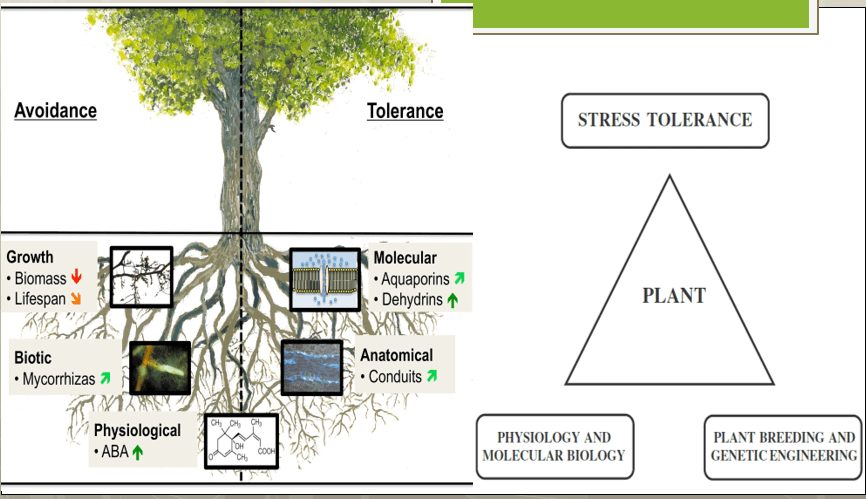Abiotic stress responses of plants
Responses at the cellular membranes level
Plant cells can sense changing environmental signals leading to significant changes in their physiology, metabolism, and gene expression.
The stress stimuli—-perceived cellular membrane level-—initiates a cascade of events to transmit the signal to various organelles thus activating the appropriate molecular network
Composition: cellulose fibrils connected by hemicellulose—embedded in a pectin gel providing mechanical strength for load-bearing. It also contains several structural proteins, phenolics, and calcium
The overall architecture of the cell wall is affected by exposure to abiotic stress depending upon the species, the stress intensity, plant phenotype, plant genotype as well as the age of plant.
Moreover, the genes encoding for cell wall proteins including arabinogalactan protein (AGP), glycine-rich protein (GRP), and proline-rich protein (PRP) are also induced in response to abiotic stress that could contribute to the cell wall strengthening.
One of the alternative responses against abiotic stress stimuli is to decrease the cell wall expansion and cell extensibility that can thus limit the water loss and prevent cell collapse due to dehydration stress
A decrease in cell wall extensibility or turgor pressure is often associated with the rigidification of the secondary cell wall by lignin deposition.
2. Modulation of photosynthetic apparatus
Abiotic stresses negatively influence the photosystems (PS I and PS II) thus reducing the photosynthetic activity along with reduced chlorophyll biosynthesis, and photosynthetic electron transport.
Theses stresses also lead to impaired RuBp (ribulose 1,5-bisphosphate) regeneration that substantially affects the Rubisco activity.
Abiotic stress——– stomatal closure —–reduced CO2 assimilation— Photosynthesis inhibition
3. Ion stress signaling and homeostasis
Abiotic stresses particularly salt and heavy metal stress are majorly responsible for an imbalance in ionic composition inside the plant cells.
For a normal metabolic function of plants, cells need to maintain high K+ and low Na+ levels.
Thus, systematic exclusion of excess Na+ ions from the cytoplasm or their accumulation within the vacuoles are the main adaptive mechanisms—-ion homeostasis against ionic stress in plants.
Ion homeostasis is maintained by ion pumps like symporters, antiporters, and carrier proteins located on the cell membranes.
4. Intracellular osmotic adjustment and osmoprotectants
The intracellular water loss from the cell due to drought and salinity stress results in cellular dehydration thus imposing osmotic stress in plants.
To counteract the effects of osmotic stress, plants accumulate certain organic solutes like quaternary ammonium compounds (proline, glycine betain), polyamines (putresine, spermine, spermidine), fructose, sucrose, sugar alcohols, trehalose, fructans, oxalate, malate, and many others.
compatible solutes—-osmolytes—osmoprotectants——-Osmotic adjustment
5. Antioxidant defense system
Most of the stress factors produce certain common effects on plants although each stress factor has got its own specific effects.
The common targets of most of abiotic stress factors are the membrane systems, which under normal conditions perform several life maintenance processes.
Therefore, all membrane involving processes will be affected by abiotic stresses.
Active/Reactive oxygen species (AOS/ROS) are always associated with aerobic life
Abiotic stresses such as water stress, salt stresses, temperature stress, light stress, nutrient stress, heavy metal stress and pollution stress are known to accelerate the production of ROS in plants that cause damage to membrane systems and other cellular processes.
Antioxidant defense under Abiotic stresses
However, the production and efficiency of the antioxidative systems depend on plant type and genetic make up of the plant.
In spite of the close association of ROS with aerobic life, their production, role, stress involvement, importance in signaling phenomena and their scavenging are not clearly elucidated.
Antioxidative systems, both enzymatic and nonenzymatic systems, play an important role in balancing and preventing oxidative damage
Abiotic stress – drought, salt, chill- increases reactive Oxygen species (ROS) in plants
ROS- stress signal- due to altered metabolic functions of chloroplast, mitochondria
Plants have various enzymatic and non-enzymatic defense systems to minimize the deleterious effects of ROS which include :
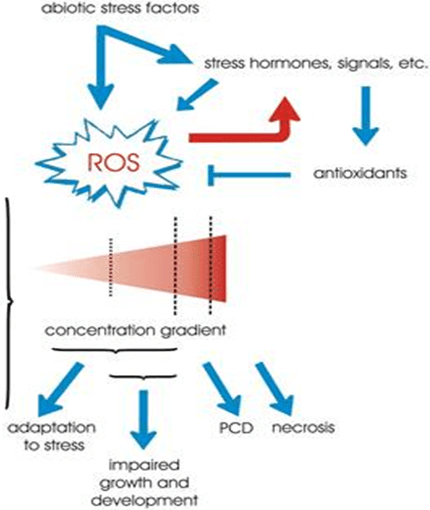
Enzymatic defense systems :
- Ascorbate peroxidase (APX)
- Catalase (CAT)
- Peroxidase (POD)
- Monodehydroascorbate reductase (MDHAR),
- Dehydroascorbate reductase (DHAR)
- Glutathione reductase (GR)
- Glutathione S-transferase (GST)
- Glutathione peroxidase (GPX)
- Superoxide dismutase (SOD) etc.
Non-enzymatic compounds: such as
- ascorbate (AsA)
- glutathione (GSH)
- carotenoids etc.
- However, under the extreme condition, ROS production overwhelm the scavenging action of the antioxidant system, which results in extensive cellular damage and death.
- In such cases external protectants as well as genetic manipulation of defense genes can work in upregulating the defense system.
There are numerous plant studies which indicate the tolerance to abiotic stresses in plants is positively correlated with an increase in antioxidants
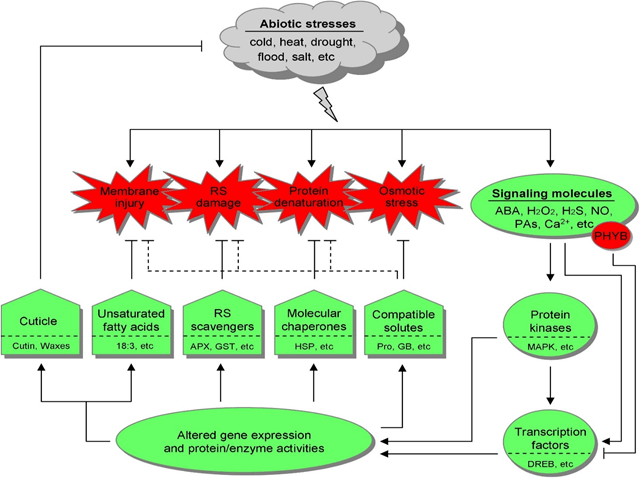
Figure 1
Figure 1 Description: The general defense systems and the underlying regulatory network in botanic responses to abiotic stresses.
Different abiotic stresses, such as cold, heat, drought, flood, and salt can provoke common cellular disorder and secondary stresses, including membrane injury, reactive species (RS) damage, protein denaturation, and osmotic stress, which are also interconnected with each other.
Accordingly, land plants have resorted to unsaturated fatty acids, RS scavengers, molecular chaperones, and compatible solutes.
Some compatible solutes may also be involved in counteracting other adverse effects, as indicated with dotted inhibitory lines.
Besides, the cuticle serves as the universal outermost shield.
Upon stress stimulation, signaling molecules mobilize the downstream effectors, primarily protein kinases and transcription factors, leading to altered gene expression and protein/enzyme activities, thereby launching the defense systems.
Notably, phytochrome B (PHYB) is emerging as a negative regulator in stress tolerance. 18:3, linolenic acid; APX, ascorbate peroxidase; GST, glutathione S-transferase; HSP, heat shock protein; Pro, proline; GB, glycine betaine; ABA, abscisic acid; PAs, polyamines; MAPK, mitogen-activated protein kinase; DREB, dehydration responsive element binding factor.
To combat stress effects plants develop some common tolerance mechanisms as well as stressor specific mechanisms to cope up with stress
However, the degree of tolerance varies from plant to plant, from low to high.
Stress tolerance mechanisms start with stress perception followed by the formation of gene products that are involved in cellular protection and repair.
The signal transduction pathways that detect stress play a crucial role in the induction of stress tolerance in plants.

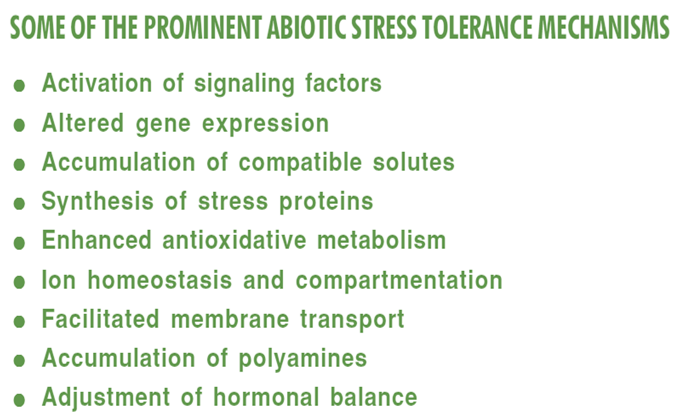
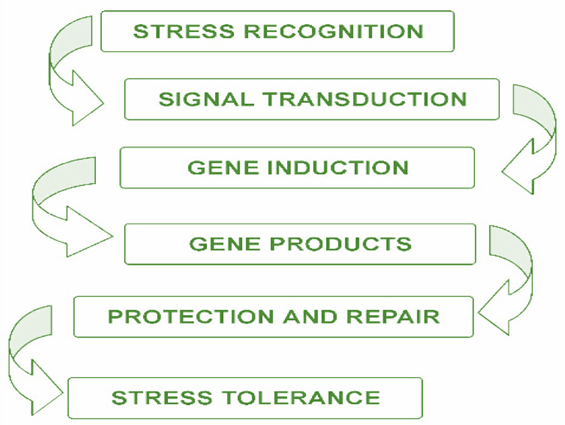
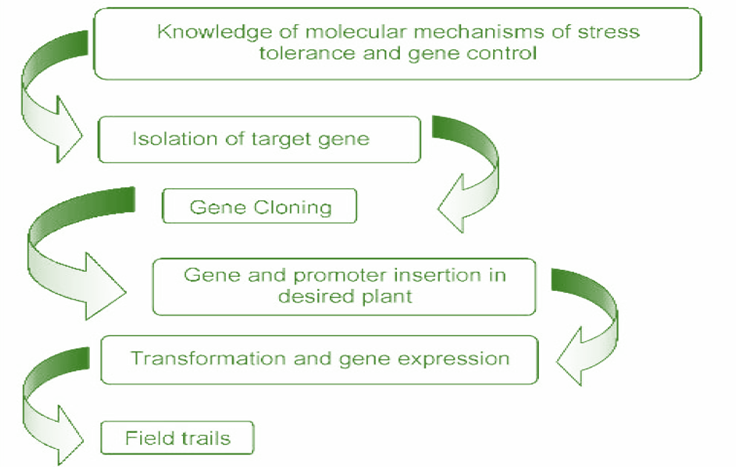
METABOLIC ENGINEERING
To cope up with different abiotic stresses, plants alter their metabolic pathways e.g.
proline, glycine betaine, polyols, antioxidant components, become more active to keep the plant survive under stress conditions.
However, the initiation and efficiency of these pathways differ from species to species or genotype to genotype to a great extent
The use of novel approaches combining the techniques of genetic, genetic engineering and molecular biology are expected to provide exciting avenues for future research.
Understanding the mechanisms by which plants perceive and transduce stress signals to initiate adaptive response is essential for engineering stress-tolerant crop plants
Conceptual grouping of plant responses to stress into gene activation for upstream signal transduction,
adaptive responses that allow the plant to change and moderate or survive the stress, and
downstream responses that result from successful adaptation or unsuccessful responses (damage). Some examples are shown for each group. Allelic variation in genes that underlie the adaptive responses should be useful in breeding programs for improved stress tolerance
FUNCTIONAL GENOMICS
Functional genomics is a field of molecular biology that attempts to make use of data produced by genomic and transcriptomic projects to describe gene (and protein) functions and interactions.
One of the important ways to develop stress tolerance is by gene transfer
Development of techniques such as cDNA libraries, molecular markers, PCR amplifications and microarray technologies made it possible to determine transcript patterns and to identify differentially expressed genes in plants.
Comparison of transcript patterns with proteome data may provide information whether the intracellular concentration of specific proteins is preferentially regulated at the level of transcription or by posttranscriptional mechanisms.
These techniques help to record the genome wide expression patterns very rapidly and with high accuracy.
The information so obtained can be integrated with functional genomic information that contributes to our understanding of the correlation between genes and phenotype of a plant
